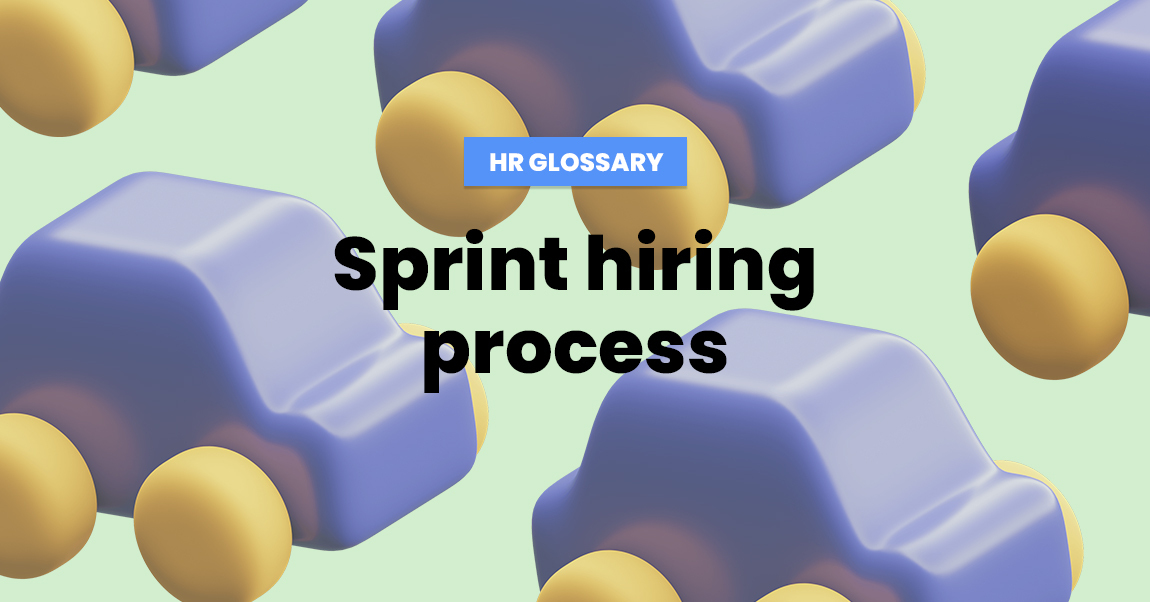If you were a proud owner of a monstrously bulky PC during the 90s, you know all about Microsoft Minesweeper. Except for one thing. You’re still slightly unclear about how to win, right? Well, recruiting sometimes has that exact vibe. Sourcing and saying mantras, monitoring the process, and hopping over stumbling blocks – over and over again. But fear not: sprint hiring may be the very strategy that will ease the struggle.
So, what is it? First of all, it’s one of the terms you’ll want to know and possibly implement. Secondly, it introduces recruiters to all of the benefits of Agile methodology. It relies on facts rather than hunches and vanquishes lucky guesses out of the picture. Now, let’s elaborate & get ready to recruit wisely!
What are the best practices for hiring?
Before getting into specifics about Scrum for recruiters and hiring managers, let’s mention a few fine procedures every organization should consider:
- Optimizing job postings and distributing them sufficiently (through relevant channels),
- Speaking out to job seekers and writing concise yet appealing job descriptions,
- Automating and simplifying all steps of the process,
- Coming prepared for every interview and making it pleasant, relevant, and informative enough,
- Onboarding new employees and helping them amplify their knowledge later on by making structured employee development plans.
These tips are pretty straightforward to follow. And yes, sticking to them will help you improve your recruitment process. In addition, you should unquestionably try out some HR tools. There’s a multitude of useful choices, and choosing the right one may require some time. Analyze your actual needs before picking your doodad & make sure its features meet your expectations.
What is sprint recruitment?
Sprint recruiting and hiring are the main agile principles embodied in a company’s processes of attracting and welcoming a candidate on board. Or, in a more clearly expressed word: sprint hiring is a flexible and efficient way to get top talents. How so? It’s simple. The two-week sprints grant the recruiters enough time to stop and evaluate the efforts, results, needed analytics, and more. Sounds good? Let’s take a closer look at its mechanisms and perks.
Sprint recruiting – essential rules to follow
When a recruiter has to juggle between multiple job openings, pending reviews, meetings, and interviews, it’s easy to get lost. Even with an ATS that matches the company’s hiring needs, it’s sometimes hard to stay in line with all the responsibilities. So, the first postulate of sprint hiring is to overcome this struggle. You will need to prioritize.
Yes, all positions need to be closed. However, not all of them are equally important at the given moment. So, what a recruiter should do is pretty simple in this case – start with the one that should be filled ASAP.
Pro tip: As for those who hire through recruitment agencies: make sure to let the team know which roles are their top priority. If a sprint is two weeks long, it’s optimal to pick three crucial positions to focus on during that time.
Did you finish up prioritizing? Moving on to the next ground rule. When we mentioned sprints, we immediately assumed they would be two weeks long. And we all know why. Most firms practice this precise format. However, the beautiful and somewhat neglected truth is that this strict time frame isn’t actually strict. It is up to you. Need more time? Take it. Used to finalizing a task in less than two weeks? Kudos, add a different schedule – just stick with it and be sure that the whole team is synced.
So, now we’ve seen how flexible sprint hiring truly is. There’s only one more rule to cover. While recruiting, there could be some impediments. The trick is to keep your sourcing and enticing process rhythmic. If you’re having a hard time overcoming a hiring struggle, discuss it. Find a solution with the help of other fellow recruiters and seek guidance from managers.
The most important tips and methods to keep in mind
The Agile manifesto came to life more than 20 years ago. The name itself is associated with swift reactions and constant movements. Its prime mission was to ease the lives of those in charge of building software products. And now, it has entered many business domains – recruitment included.
So, what are agile hiring methods and how do they work? In short, it comes down to working in sprints, prioritization of tickets, and periodic feedback. That way, the whole drill becomes more straightforward and flexible. Moreover, every participant, hiring managers included, has a better overview of the process and each candidate’s progress through the pipeline.
Here are some of the methods you should keep in mind:
- Define the actual hiring need before defining the necessary skills for a specific role,
- Take care of your tone and style in order to source and entice the most qualified applicants and passive talents,
- Make sure to have a few excellent perspectives in your pool within a few days,
- Aim for the most fitting ones, but don’t expect perfection,
- Use your marketing skills to attract more candidates and structure the selection process carefully to pick the most suitable 3 or 4 potential hires,
- Track, review, and comment on your efforts frequently and be consistent about it.
Boolean search is one of the fantastic ways to stumble upon the most fitting LinkedIn titles and superb profiles. However, it’s better to truly engage and conduct your search through and through. Lastly, you need to ensure that your sourcing is on track and confirm it every two weeks. So, by the second week, your interviewers should already meet a suitable talent or at least review their resume and schedule a chat with them.
How do you create a hiring framework?
Setting up a framework that works equally well for each business is a bit of a challenge. More importantly, if you’re looking for an ideal way to establish an agile hiring framework and grow your team, know that it needs to be evaluated, then done according to your precise objectives.
However, some steps are inevitable – and that’s what makes sprint hiring effective and worthy:
- Start by gathering your team and knowing your KPIs (+ ensuring that everyone understands them),
- Make a plan or set a goal, and then break it down into several assignments that will lead toward the ultimate result,
- Track your progress and visualize it,
- Have regular meetings, one-on-ones, and performance reviews,
- Keep track of each relevant hiring metric and assess how they affect your success,
- Get ready to modify the process when necessary.
It doesn’t sound that tricky, right? All you need is to stay in tune and learn how to segment your tasks and projects.
Here’s an example of a hiring framework done well
Taking smaller steps while setting your aims toward the big picture is the key. Now, if you do it all correctly, the first tasks should entail sourcing the candidates and introducing their CVs or profiles to hiring managers after the first week. Then, you can collect feedback and maybe retarget your candidates in the week to come. The next two weeks will be reserved for screenings and technical interviews.
This timeline is just an example of how many organizations do it. Wanna establish your own pace? Go ahead, just keep it smooth, simple, and harmonious.
Meanwhile, don’t forget the KPIs. What should you pay attention to? Well, there are a few essential factors, but the main ones are cost of hire, time to hire, source of hire, acceptance rate, and a few other related metrics. How do KPIs work? Set them at the very beginning and monitor them throughout the processes. The great thing about them is that you can alter them as you advance.
Still, it could be somewhat difficult to track everything without using a single tool that will help you visualize. There are numerous ways to track progress and stay aligned. For instance, if Kanban works for you, you’ll simply love Trello. Explore your options and track your candidates and results. In addition, these tools will be an excellent reminder during daily meetings. Do these frequent chit-chats sound exhausting? Nothing to worry about – they should be brief and concise. If not, you’re doing something wrong. Stop and smell the to-the-point meets and daily stand-ups.
Main benefits of a sprint hiring process
By now, you must have grasped some of the advantages of embracing agile principles when hiring. Still, let’s name them and ensure that everyone knows how significant it is to set up a framework properly:
- Better hiring practices means the easier overcoming of familiar troubles like shortage of talents,
- More involvement and a greater deal of transparency will enhance the processes and ease the decision-making,
- Frequent problems that pop up due to unrealistic expectations are much easier to deal with, and the requirements can get changed along the way.
Aside from all this, the entire deal is far more versatile, easy-going, and flexible. These days, that’s what everyone is looking forward to, regardless of whether they work remotely or on-site.
Set up an agile recruitment process correctly – Learn what not to do
Sometimes, agile recruitment doesn’t deliver the expected results. Or it just fails completely. Now, more than 60% of those who have bumped into an unfavorable outcome claim that their company culture simply wasn’t compatible with this manifesto and the way it works.
Nevertheless, there are far more dangerous territories to step into. For instance, here’s one scenario when sprint hiring is doomed to disaster: management isn’t communicating properly with the recruitment team. Now, this is a story that you need to avoid by all means. The lack of insights will harm any recruiting process, for that matter. Keep everyone informed and strive to be as transparent as possible.
In addition, agile recruitment is known for flexibility. And it’s safe to say – it largely relies on pivoting. Still, too many shifts will leave a recruiter baffled. Experiment, explore, assess, but don’t exaggerate and don’t leave the people wondering what their aims are.
Know the perks and practices of sprint hiring & reach your targets
So, what’s your resolution? Will you go agile and choose to enhance your recruitment strategy by being more flexible, pivot-inclined, and transparent? If so, be sure to try out a few approaches before setting an exact framework you’ll keep relying on. And if you need a skilled recruitment agency to team up with, pick one that already lives and promotes agile principles.




